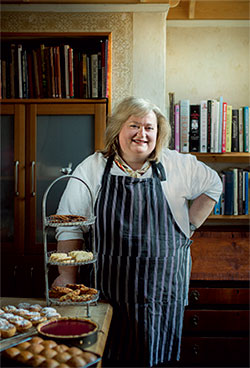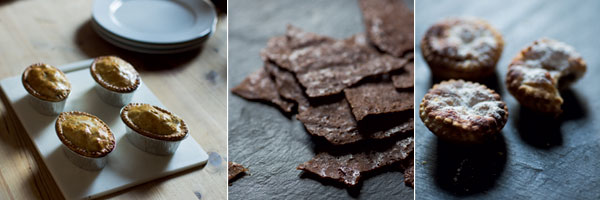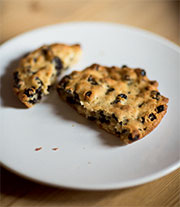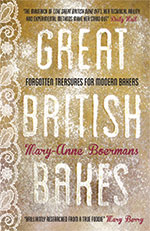The greater British bake-off

Simply sign up to the Life & Arts myFT Digest -- delivered directly to your inbox.
Mary-Anne Boermans opens the door of her little terraced house in Kidderminster and it is instantly clear that this will be the perfect day. The air is scented with spice, a drift of nutmeg and mace coiling enticingly through the front room. Set on the dining table are festive treats, all “traditional” but with the historical twist that gives Boermans’ baking its fascinating character.
Here are pretty little shortbreads, not plain but dotted with orange peel. Here is gingerbread, not cakey but cracklingly fragile and bittered with treacle. Here are Chelsea buns but entirely without the crowds of currants we’ve come to associate with that treat. It’s shocking. They look naked. But turn to Boermans’ new book, Great British Bakes, and you will discover why – for she has traced the true 18th-century origins of the “Royal Chelsea bun” with a diligence that would put many a historian to shame.
Boermans – who played rugby for Wales in the late 1980s, and who has travelled the world in the course of her teaching career – is perhaps the most wonderfully unlikely contestant The Great British Bake Off has seen: and lucky for us. Let’s face it: the programme is kitsch, pure and simple, and so it’s a wonder to discover that an amateur who got her professional start there – she was a runner-up in 2011 – has produced a book that’s as fascinating to read as it is to bake from. Its recipes are drawn not only from her collection of hundreds of second-hand, antique cookbooks but also from the Wellcome Library – which, being a medical library, keeps recipe books because they contain home remedies. But there’s no reason you can’t find a cheesecake in there, too. What Boermans has done is to choose her favourites and then modernise them both for our present-day kitchens (we take it for granted that our ovens will run at a constant temperature – a fairly recent development) and for the fact that we cook for ourselves rather than asking a kitchen maid to keep whisking a batter for eight hours solid. (Thank heavens for the Kenwood.)
And so where better to come than Boermans’ neat galley kitchen to find a version of a Christmas cake that will bring us back to the essence of British baking? For that’s what she was after. When her daughter, now eight, was born, she says, “I wanted her to taste pure flavours. I know myself how delicious artificial flavours can be. When I was a child a real treat was Angel Delight – because we had to have home-cooked meals! You didn’t buy biscuits or cake – ‘boughten’ stuff was looked down on. So it got me thinking: but which apple pie is the best apple pie – and who first thought of apple pie?”

It was this that led her to start picking up second-hand cookery books in shops and on eBay. “I began to think: it’s wrong to dismiss 400 years of baking and cooking in general.” And, she adds, “It can be new if we haven’t done it for 200 years.” In these old recipes, the newly trendy nostrums of eat fresh, eat local, eat nose-to-tail, be self-sufficient, were all right there, waiting to be rediscovered.
As we chat, we make Wood Street Cake – a lightly yeasted fruitcake with a rosewater icing originating in the City of London. Wood Street is just between Cheapside and Cripplegate, and, in the 17th century, was famous for its cakes. So when, in 1648, Lady Anne Murray helped to smuggle the future King James II out of captivity and off to the continent, she not only provided him with women’s clothes as a disguise but also his favourite treat, a Wood Street Cake. In her book, Boermans admires Lady Anne’s devotion: “I must admit that, were I to be intimately involved in the rescue of royalty in a time of civil unrest, the provision of snacks might be pretty low on my checklist of important tasks.”

We can only be thankful that political calm has enabled Boermans to focus on such snacks. Having folded a mixture of dried fruit and currants into the dough, which is deliciously enriched by butter and cream, we need to give it an hour to rise – time enough to eat lunch, for which she has made little oval cheese and potato pies, their crusts made meltingly delicate by cutting plain flour with a good dose of cornflour. Normally, such a pie wouldn’t be what I’d choose for my lunch: but these are straight-up fantastic. It doesn’t surprise me when Boermans confesses a secret love for savoury baking – here’s to a follow-up volume, I say.
Hot water crusts for pork pies were something she’d never made until GBBO – an experience which, all in all, she loved. “There was a lot of laughter in that tent, a lot of funny people. I’m really glad I met all of them, it was just a shame that one went every week.” She is full of admiration for Mary Berry – “At first I wanted to impress her; then I didn’t want to disappoint her.” Paul Hollywood’s name doesn’t elicit the same admiration – not least because he called her everlasting syllabub “revolting”, which I rather agree is beyond the pale. She admits, however, that the kind of baking she’s interested in was perhaps not the perfect fit for GBBO – their loss is our gain.
After the cake has risen, we set it in a tin lined with parchment that rises above the springform walls so the fruit doesn’t scorch. Once out of the oven, the cake is iced hot – egg whites, confectioner’s sugar and rose water, that’s it. It’s a perfect, simple Christmas cake, one that comes with the romance of history attached. We can be sure there’s more to come from Boermans. “Think of the stories I haven’t managed to find yet!” she beams.
‘Great British Bakes: Forgotten Treasures for Modern Bakers’ by Mary-Anne Boermans (Square Peg, £20)
——————————————-

Wood Street Cake (1675)
The cake itself is light and delicately spiced.
The high fruit content means that only a relatively small amount of sugar is needed and, like most of the fruited cakes of this era, it is iced hot. And so, without further ado, please enjoy a cake fit for a king.
Serves 10-12
For the cake
600g plain flour
2 sachets (14g) fast-action yeast
112g caster sugar
1 tsp ground mace
½ tsp ground cloves
1 tsp ground nutmeg
2 tsp ground cinnamon
450g currants
150g raisins
150g butter
200ml double cream
2 egg yolks
1 egg
1-3 tbs rose water, to taste
For the icing
2 egg whites
1-2 tbs rose water, to taste
225g icing sugar
A 24cm springform cake tin
● In a large bowl, mix together the flour, yeast, caster sugar, spices, currants and raisins.
● Put the butter and cream into a saucepan over a low heat and warm gently until the butter is melted. Set aside to cool slightly.
● In a separate bowl whisk the yolks and egg with the rose water, then continue to whisk while slowly adding the cooled cream mixture.
● Stir the liquids into the dry ingredients. The texture should be rather wet and similar to a modern fruit cake mix – too wet to knead. When thoroughly mixed, cover and set aside to rise in a warm place for 1 hour.
● Preheat the oven to 200C/180C fan/gas 6 and grease and line the base of the cake tin with baking parchment. Line the sides with a double layer of parchment and make sure it stands above the level of the tin itself by several centimetres. This will help keep the top of the cake from scorching and also prevent the icing from colouring too much.
● When the cake mix has risen, pour it into the prepared cake tin. Smooth the mixture but don’t press down or you’ll squash out all the air bubbles. Bake for 45-50 minutes.
● While the cake is baking, prepare the icing by whisking the egg white to soft peaks and then adding the rose water. Gradually add the icing sugar and whisk to stiff peaks. Set aside.
● When the cake is fully baked, remove it from the oven and, while it’s still in the tin, spoon the icing over the top. Return the iced cake to the oven and turn off the heat. Let the icing set for 15 minutes then remove the cake from the oven and leave to cool in the tin.
● When it’s completely cold, remove the cake from the tin. Run a knife around the edge of the icing to loosen the baking parchment and slowly peel away the paper.
——————————————-
History joys
Mary-Anne Boermans chooses three favourites from her collection of historical recipe books:
Good Things in England by Florence White (1932). ‘Her pioneering efforts attempted to “capture the charm of England’s cookery before it is completely crushed out of existence”. Over 800 recipes dating back 700 years.’
The Housekeeper’s Pocket Book by Sarah Harrison (1739). ‘Includes a “food-in-season” planner, with recipe suggestions for each item. Interesting West Country perspective.’

A New System of Domestic Cookery by Maria Rundell (1806). ‘The first (in my opinion) practical household book. It was a huge success, remaining in print for 35 years and over 40 editions.’
——————————————-
FT reader offer
Readers can buy Great British Bakes: Forgotten Treasures for Modern Bakers by Mary-Anne Boermans (RRP£20) for the special price of £17, including free UK p&p. To order please call 01206 255 800 and quote the reference ‘FT’.
Offer dates: 30/11/13-31/01/13
Comments